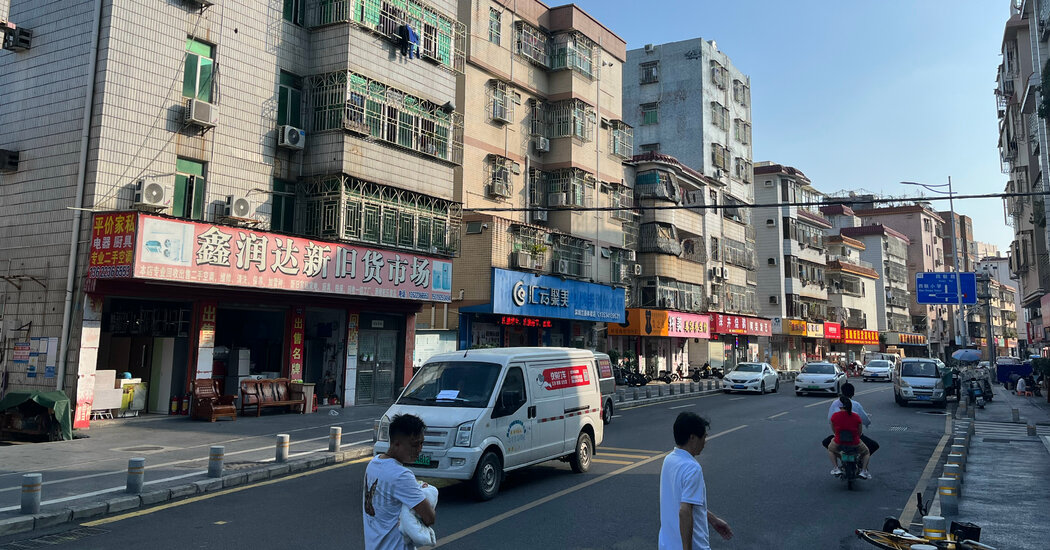The Places Most Affected by Remote Workers’ Moves Around the Country
In prepandemic times, the few Americans who worked from home appeared relatively settled there.
They were less likely to move than other workers. And they probably had less reason to: If you were sitting in a rare job in 2018 that enabled regular work from home — and your life was adjusted to that good fortune — why move somewhere new?
The abrupt rise and shifting nature of remote work over the last few years has upended this pattern, according to an Upshot analysis of census migration data. During the pandemic, people who worked from home became significantly more likely to move — and more likely to do so than all other workers:
Share of Workers Who Moved in the Prior Year
A line graph of the share of workers who moved in the previous year, showing a pandemic jump in the mover rate for remote workers.
Source: American Community Survey
This rising mobility was driven by remote workers who sought new housing in their same metro areas, but also by a wave of remote workers decamping to other parts of the country. In the first two years of the pandemic, one in four workers who moved long-distance was working remotely in a new home — a previously unheard-of scale of remote migration.
In the two years leading up to the pandemic, for example, about 20,000 remote workers moved away from the San Francisco metro area. Then during 2020 and 2021, 110,000 did.
In those prepandemic years, about 40,000 remote workers moved away from metro New York. Then, 200,000 left in two years.
The rise of remote work meant that many such workers moved into these places, too. But for New York, San Francisco, Washington and Los Angeles, significantly more remote workers left than arrived. By contrast, Austin, Denver, Dallas and Nashville all attracted a net influx of people working from home.
Major Metros With the Most Remote Migration During the Pandemic
A high share of all workers moving in and out of these metros was remote. But expensive metros lost more than they gained.
| Movers who work remotely |
Net migration of remote workers |
|
|---|---|---|
| San Francisco | 42% | -32k |
| San Jose, Calif. | 40% | -27k |
| New York | 36% | -116k |
| Los Angeles | 34% | -53k |
| Washington | 33% | -11k |
| Austin, Texas | 32% | +28k |
| Seattle | 31% | -3k |
| Raleigh, N.C. | 30% | +7k |
| Chicago | 30% | -29k |
| Boston | 29% | +8k |
| Denver | 28% | +23k |
| Portland, Ore. | 28% | +9k |
| Richmond, Va. | 26% | +5k |
| Minn./St.Paul | 26% | +1k |
| San Diego | 26% | -1k |
| Philadelphia | 26% | -1k |
| Dallas | 26% | +10k |
| Sacramento | 25% | +4k |
| Hartford, Conn. | 25% | -3k |
| Nashville | 25% | +10k |
Source: Upshot analysis of American Community Survey data from 2020-21.
That mirrors a pattern identified in an earlier Upshot analysis that showed college-educated workers were increasingly migrating away from the most expensive parts of the country and toward relatively more affordable major metros. During the pandemic era, remote work helped accelerate that shift. For every 10 workers who left the San Francisco and San Jose metros during the pandemic, four were working remotely in their new home. For every 10 workers who moved into Austin, three were working remotely there.
Look Up Migration Data Where You Live
A search tool of migration data showing how the pandemic altered patterns for individual metro areas.
New York Metro Area
Net domestic migration of workers
Source: Upshot analysis of American Community Survey data
Limited to metros of more than 250,000 residents.
The remote workers able to make these moves tend to have higher incomes. In fact, the higher a worker’s income, the more likely that person is to be remote — a pattern that became much more pronounced during the pandemic:
High Earners Became Even More Likely to Work Remotely
Percent working from home, by income rank
Source: American Community Survey
This means that higher-income households are better able to take advantage of the opportunity remote work has presented to move to more affordable communities (either farther out in the suburbs, or in another part of the country). And for the expensive places that have lost remote workers, this means they have increasingly lost tax revenue and consumer spending power associated with high earners.
“The real power of demographic change isn’t in one year — it’s whether these patterns persist year over year over year,” said Hans Johnson, a demographer with the Public Policy Institute of California. For some parts of the country, however, these trends already raise big questions. For one, Mr. Johnson asked: “Does the move to remote work for highly educated and high-income workers change who lives in California?”
Where the remote workers went
In general, remote-work migration has affected two kinds of places in particular: major metros where the local economy is geared toward the types of jobs that can be done from home, and smaller vacation hubs that promise people who can live anywhere a high quality of life.
In the first category, the Bay Area, Washington, Austin, Denver and New York all rank high among metro areas with more remote-friendly jobs (they have many software developers and management analysts, not so many mining machine operators or logging workers). In migration data, these places both attracted and lost remote workers in large numbers during the pandemic, although the net effect of that churn varied by metro.
In the smaller, scenic vacation spots that also jump out in the data, more remote workers have been moving in than might be expected given the makeup of the local economy and the total scale of migration there.
This second group includes communities in and around Ocean City, N.J.; Cape Cod, Mass.; and the Salisbury, Md., metro, home to Maryland and Delaware beach towns popular with vacationers from the Washington area.
Vacation Towns Saw a Surge of Remote Workers Moving In
Among metros where many homes are intended for seasonal use, the pandemic brought a boom in remote migrants.
Remote in-migration
| Pct. seasonal housing |
Prepandemic 2018-19 |
Pandemic 2020-21 |
|
|---|---|---|---|
| Ocean City, N.J. | 47% | <500 | +2k |
| Cape Cod, Mass. | 38% | +1k | +5k |
| Naples, Fla. | 30% | +3k | +7k |
| Salisbury, Md. | 28% | +1k | +5k |
| East Stroudsburg, Pa. | 23% | <500 | +1k |
| Myrtle Beach, S.C. | 23% | +2k | +5k |
| Cape Coral, Fla. | 23% | +4k | +10k |
| Panama City, Fla. | 22% | +2k | +4k |
| Duluth, Minn. | 20% | <500 | +2k |
| Punta Gorda, Fla. | 20% | +2k | +3k |
Source: Upshot analysis of American Community Survey data.
During the pandemic, more than a quarter-million American workers moved to metros with a high share of homes intended for seasonal use — a good proxy for places that are effectively vacation destinations. That’s two and a half times as many as moved there in the previous two years. Nearly half of these new migrants said they were working from home.
Exurbs or exiting the area entirely?
This analysis relied on a question in the American Community Survey asking people how they “usually” got to work in the past week, including by car, bus, subway, ferry — or by working from home. The remote workers identified this way may range from hybrid workers who primarily work from home to permanent remote workers and self-employed people who have no nearby office to visit. Left out of these numbers are probably people who work only a day or two a week from home, or less.
The precise form of remote work matters a lot for patterns in where people move. A remote worker who still has to visit the office occasionally may move to the exurbs of the same metro area (as pandemic-era research suggests people have done). A remote worker who never has to visit the office may be free to relocate across the country.
One reason remote-worker mobility rose during the pandemic was that many people, all at the same time, were newly given one of those two options. The nature of remote work itself also shifted. If the phrase previously conjured the few people who got to stay home three days a week, now for many white-collar workers it means they can decouple their home and work locations entirely.
“The people that worked remotely prepandemic are very different than the people that work remotely now,” said Nicholas Bloom, a Stanford economist who studies remote work. Remote workers prepandemic were often taking a small pay cut for the accommodation, he said. They were more likely to be women, and to have caregiving responsibilities, disabilities or other considerations that necessitated working from home.
During the pandemic, those rare accommodations became expected perks for many more workers. And this expanding, shifting pool of remote workers encountered a changing job market, one where it became much easier to interview online (and discreetly at home) for new jobs.
“All of this pushes towards a higher mobility rate,” Mr. Bloom said.
Whether that continues will depend in part on how employers handle remote work in the years to come. If more companies ultimately demand hybrid patterns, that could dampen long-distance mobility tied to permanent remote work. If more companies embrace remote work fully, that could give some workers newfound confidence to relocate.
We may even see workers sorting into jobs and career tracks that allow remote work, said Adam Ozimek, the chief economist at the Economic Innovation Group. As remote work’s effects ripple across the economy and the housing market, Mr. Ozimek has found in research with Eric Carlson that remote work has even driven new household formation (imagine two remote-working roommates now each needing a separate home). That, on top of everything else, would push up mobility, too.
It’s also possible that many of the people who were given a chance to work remotely for the first time in the last few years have now settled into new patterns — and new locations and homes — better fitting that opportunity. That could mean remote workers will eventually start to look more settled as a group again.
But, Mr. Ozimek cautioned, “we’re a long way off from the equilibrium there.”


